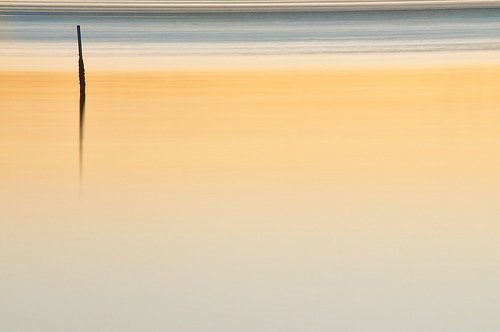Closely related to the question of “how low can you go” is the philosophical issue of, “how simple can you get?” Images like Story of O and Line Dance (below) examine this question. Story of O presents an arch and its reflection, creating a circular letter ‘O’ or zero, on a gradient monochrome background. Line Dance is slightly more complex in terms of composition. It shows an irregular upright line and its reflection in the upper-left quadrant, created by an old piling. The lower portion of the image is a smooth color gradient going from blue to orange, with gentle horizontal lines formed by waves and again in blue cutting across the vertical line of the piling at the very top of the image.

In both cases I used a long exposure to smooth the action of the ocean, and to create the sense of spatial isolation that simplicity requires. Story of O was a sixty second exposure, and Line Dance was exposed for ten seconds. The ten second elapsed time duration was long enough to smooth out the foreground while still leaving some detail in the horizontal lines formed by the waves at the top of the image.
Pulling off a simple composition can be surprisingly complex. For one thing, by its nature simplicity calls attention to itself, so the composition will be scrutinized. When you have one or two compositional elements, each will get a great deal more attention than when there are hundreds of things to look at. In other words, with the simple composition there is no place to run, and no place to hide.
The things that bring us most joy are not overly complicated. Perfection in an image usually involves creating a sense in the viewer of righteous simplicity. Partly for this reason, simple compositions are likely to be regarded as audacious, and as an attempt by the artist at the Platonic ideal and the perfect. If you would joust with perfection, then expect to be regarded with rigor. There’s no margin of error in the lineaments of the simple composition.